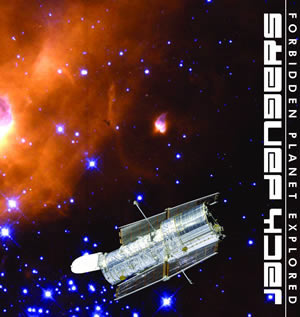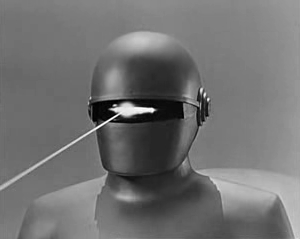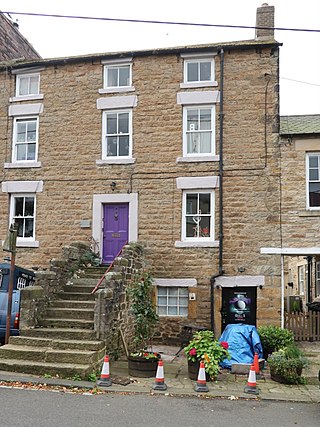Story background
Robby the Robot originated as a supporting character in the 1956 MGM science fiction film Forbidden Planet. [4] The film's storyline centers on a crew of Earth explorers who land their starship, the C57-D, on the planet Altair IV, inhabited by the mysterious human Dr. Morbius and his daughter Altaira who was born there. Robby is a mechanical servant that Morbius has designed, built, and programmed using knowledge gleaned from his study of the ancient Krell, a long-extinct race of highly intelligent beings that once populated Altair IV. The film’s plot is loosely based on William Shakespeare’s play The Tempest (1610), with the planet Altair IV standing in for Shakespeare’s remote island and Dr. Morbius for Prospero. In this context Robby is analogous to Ariel, a spirit enslaved by Prospero.
Robby exhibits artificial intelligence, but has a distinct personality that at times exhibits a dry wit. He is instructed by Morbius to be helpful to the Earthmen and does so by synthesizing and transporting to their landing site 10 tons of "isotope 217", a lightweight though still effective replacement for the requested lead shielding needed to house the C57-D’s main stardrive to power an attempt to contact Earth base for further instructions. Morbius programmed Robby to obey a system of rules similar to Isaac Asimov’s Three Laws of Robotics [1] [2] as expressed in I, Robot (1950). [5] One of the laws is a rule against harming or killing humans. This becomes an important plot point near the conclusion of the film when Robby refuses to kill the Id monster; he recognizes the invisible creature to be an alter ego/avatar of Dr. Morbius. Hollywood purposely, and misleadingly, depicts Robby in the film’s advertising posters as a terrifying adversarial creature carrying a seductively posed unconscious maiden (Altaira), but no such scene is in the film and the images do not reflect in any way Robby's benevolent and intelligent character. Robby only carries one person during the film, the Earth starship's Dr. Ostrow, when he is mortally wounded near the end of the film.
Design and construction
Robby was designed by members of the MGM art department and constructed by the studio's prop department; [1] The design was developed from initial ideas and sketches by production designer Arnold "Buddy" Gillespie, art director Arthur Lonergan, and writer Irving Block. [4] These concepts were refined by production illustrator Mentor Huebner and perfected by MGM staff production draughtsman and mechanical designer Robert Kinoshita. [6]
The robot's groundbreaking design and execution represented a radical advance on the conventional "walking oil-can" depictions of robots in earlier feature films and movie serials. The only previous film robot of comparable style and quality was the "Menschmaschine" created for Fritz Lang's Metropolis (1927). However, this did not come cheap: As with every aspect of the production of Forbidden Planet, MGM spared no expense on Robby's design and construction. With reported costs ranging from $100,000 and $125,000 [7] [8] (equivalent to at least $US1.1 million today) it was, proportional to total budget, one of the most expensive single film props ever created up to that time, which represented nearly 7% of the film's total budget of US$1.9 million. (By way of comparison, Robby cost roughly the same, proportional to total budget, as the massive 27-ton, 12 meter-diameter, rotating centrifuge set built for Kubrick's 2001: A Space Odyssey , which cost US$750,000 against a total budget of around US$11 million). But thanks to its imaginative design, intricate detailing, and the very high visual quality of the final product, Robby immediately became the "face" of the film and soon became an enduring popular culture icon.
Robby was constructed using a range of materials including metal, plastic, rubber, glass, and Plexiglas. The plastic parts were a pioneering example of the use of the then novel technology of vacuum-forming heated plastic over wooden molds. These parts were made from an early form of ABS plastic with the brand name "Royalite", a material mainly used at the time for making suitcases. The finished Robby stands just over 7-foot (2.1 m) tall and was fabricated in three detachable sections: the legs and lower torso, the barrel-like chest section (which included the arms), and the highly detailed head piece.
The tall paraboloidal plexiglass dome that covered the head housed the detailed mechanisms representing Robby's electronic brain. These included a "pilot light" at the very top, an intricate apparatus terminating in three white wire-frame spheres that rotate in planetary fashion (representing his gyroscopic stabilizers), a pair of reciprocating arms in the shape of an inverted "V", multiple flashing lights, and an elaborate horizontal array of moving levers resembling saxophone keys. Conical protuberances attached to each side of the head carry two small forward-facing blinking lights (his eyes) and two rotating chromed rings, one mounted vertically and the other horizontally, which represent Robby's audio detectors (his ears). The bottom front section of the head is a curved grille consisting of parallel rows of thin blue neon tubes, which light up in voice synchronization when Robby speaks. This neon grille also enabled the operator to both see out and to breathe. The joint between the head and chest section was fitted with a custom-made bearing that allowed the head to rotate in either direction.
Robby's bulky barrel-shaped torso (a sly reference to Bob Kinoshita's earlier job as a washing machine designer) featured a front panel fitted with a rectangular door at the top (into which samples of any substance could be inserted for Robby to analyze and replicate); underneath the slot were two rotating discs fitted with small flashing lights and below that a row of five buttons that moved in and out. Robby's thick, stubby arms were connected to his body with plastic ball-joints that fitted into matching sockets in the torso, allowing the joints a small amount of rotational movement. The arms could also be extended and this section was covered with an expanding concertina-type tubular rubber sheath. Robby's three-fingered hands were also made of rubber, finished with the suit's overall gunmetal metallic gray paint. The chest section attached to the leg section with special locking clips. The bottom section of the suit hinged at the top of the legs, allowing Robby to both bend forward and swing each leg backward and forward slightly, enabling him to walk with relative ease (albeit with rather small and stiff steps). Robby's legs were made from interlocking globes of vacuum-formed plastic, which were connected by internal jointing that permitted the entire leg to bend slightly, but cleverly concealed the movement of the hips and knees of the human operator inside.
Robby's design was a major advance on all previous screen robots in many practical and aesthetic respects. By comparison, the robot Gort, the menacing "interstellar policeman" from the science fiction film The Day the Earth Stood Still (1951) was a very tall man in the robot suit, and its smooth design posed several practical problems for shooting. Because it was made of flexible neoprene overall, similar to a skin diver's wetsuit, the props team had to fabricate two suits that laced up in order to keep the fastenings out of sight while filming Gort moving: One suit laced up at the back (for frontal shots), and the second, which laced up from the front, was used for the shots in which Gort was seen from behind. The neoprene suit creased at the hips, back knees, and front elbows when the actor inside moved, giving the impression of being made from a flexible alien metal. The filmmakers diminished the effect by cleverly keeping Gort's movements to a minimum or by only shooting his upper body when he walked.
Robby's similar size and its construction from rigid sections that had articulated joints combined to create a convincing viewing experience. To access the suit, the three sections were dismantled and the operator climbed into the legs. The torso was then placed around him, the two sections were secured with internal clips, and the operator was strapped into an internal over the shoulder harness; finally the head was fitted, the internal electronics were connected to external power via hidden cables, and the suit was switched on and ready for filming. This design made it possible to film Robby from any angle and for him to move about and carry out the actions required in a scene, without either betraying the obvious presence of an interior operator or revealing how each got in and out; Robby was operated (uncredited) by stuntmen Frankie Darro and Frankie Carpenter, both short actors (Darro was 5'3").
One of the suit's few drawbacks was that the many intricate moving parts in the electrified headpiece made a considerable amount of noise when Robby was powered up. During shooting, Robby's voice was performed off-camera by an uncredited actor, who spoke lines into a microphone that fed into a voice-actuated circuit connected by a cable running into Robby's foot, up through a leg, and all the way to the neon tubes in Robby's lower headpiece; this device generated a control voltage that synchronized the voicebox's flashing neon tubes. Robby's screen voice in the finished film was re-recorded in post-production by actor Marvin Miller. (Actor Les Tremayne read the film's opening prologue.)















